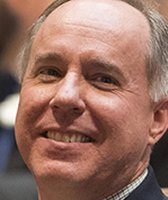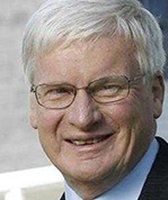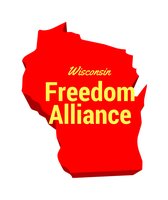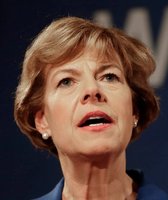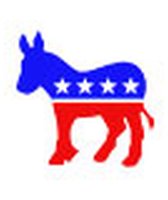Get PolitiFact in your inbox.
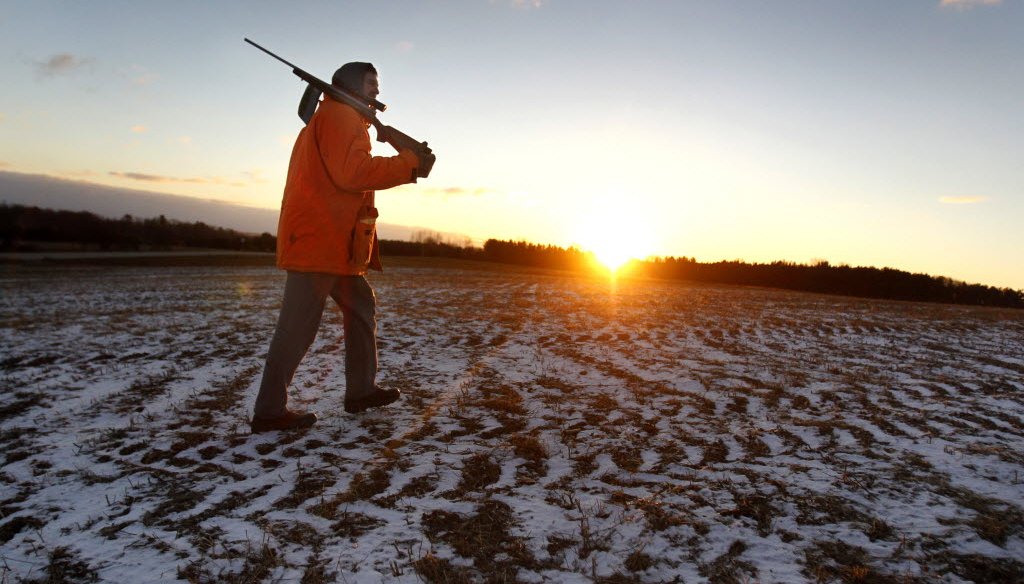
Jeff Peters crosses a frozen cornfield at sunrise on the way join his son in their deer stand on the opening day of the 2013 deer hunting season Nov. 23, 2013 near Shiocton, Wis. (AP Photo/Post-Crescent Media)
Vos says nine-day deer hunt has $1.3 billion impact
A physicist, an engineer and a statistician are out hunting. Suddenly, a deer appears 50 yards away.
The physicist does some ballistic calculations, assuming a vacuum, lifts his rifle to a specific angle, and shoots. The bullet lands 5 yards short.
The engineer adds a fudge factor for air resistance, lifts his rifle slightly higher, and shoots. The bullet lands 5 yards long.
The statistician yells "We got him!"
PolitiFact Wisconsin couldn’t help but recall that chestnut as we started fact-checking a claim by Assembly Speaker Robin Vos (R-Rochester).
"FYI," Vos posted on Facebook Nov. 22, 2013, the eve of Wisconsin’s biggest hunting season, "the nine-day deer hunt contributes more than $1.3 billion in revenue to the state of Wisconsin."
Did Vos bag one when describing the impact of 615,000 hunters taking to the woods?
At least one of our readers heard the claim as a reference to how much state government pulls in from the hunt. That’s a much smaller figure: Deer hunting licenses and permits generated $22.7 million in revenue for the DNR in 2010, the latest year available.
Vos spokeswoman Kit Beyer told us he meant the broader impact on the economy of hunting-related spending. That’s how we read it, too. The same number was referred to by Gov. Scott Walker and others in their own pre-hunt statements.
Walker’s news release cited the state Department of Natural Resources, which pointed to a 2006 study, "Hunting in America," by the Association of Fish and Wildlife Agencies.
That 2006 study estimated direct spending by deer hunters at $899 million. That means money spent on gas for the pickup truck, food and beverages, firearms, ammo, lodging and other essentials, say, a new trailer, a gun case, land access fees, etc.
The figure, gleaned from a large national survey conducted by the US Census Bureau, reflects that direct spending by hunters. But the study also estimates the "ripple effect" of their spending on the broader economy. That’s the $1.39 billion, cited by Vos and the others.
The study uses a pretty broad definition of ripple effect.
It quantifies such indirect spending "as retailers buy more merchandise from wholesalers and manufacturers who then buy more input, plus the spending by the employees of all these companies," said Rob Southwick of Southwick Associates, which does the estimate. "It is possible to divide and track retail sales as they move through the economy, with each successive round becoming smaller until it’s no longer possible to measure."
So it’s a much softer estimate than the direct spending. Such measures always are.
It’s worth noting that $1.39 billion figure includes more than the just-concluded nine-day gun hunt mentioned by Vos. There’s a separate bow-hunt season as well.
It’s not possible to tease out exactly how much spending is for bow vs. gun, and there is some overlap. But based strictly on licenses for all kinds of deer hunting, 74 percent are for the gun season (615,000 licenses).
Applying that ratio, the direct spending for the nine-day gun season would be $665 million, and about $1.03 billion for indirect.
Featured Fact-check
That’s lower than Vos said.
But because the figure is old, we thought it made sense to apply a simple inflation calculation to the gun deer-hunting numbers we extrapolated from the study’s overall deer hunting figures.
The overall impact, including "ripple effect" spending, would be about $1.2 billion -- but given the overlap with spending between gun and bow hunting for deer -- probably somewhat higher.
Newer numbers
We found a study that updates the 2006 calculation. The 2011 report was by the National Shooting Sports Foundation in partnership with the Association of Fish and Wildlife Agencies. The NSSF is is the trade association for the firearms industry.
That 2011 study showed a surge in the number of deer hunters in Wisconsin, and a 146 percent jump in direct and indirect spending, up to $3.4 billion from the earlier $1.39 billion. Similarly, the direct spending by hunters rose from $899 million to $2.17 billion.
The study is more recent, and shows a bigger impact, so you might expect the political types to latch onto it, right?
Not in this case, due to concerns raised by a Wisconsin DNR official who urged elected officials to use the more conservative figures.
The 2011 study showed a big increase in Wisconsin deer hunters when the number of hunters actually went down, based on the number of licenses sold, said Keith Warnke, hunting and shooting sports coordinator at DNR.
What’s more, Warnke said, it defies logic that spending by hunters more than doubled during the Great Recession. The 2006 direct spending breaks down to $1,400 per hunter -- a reasonable estimate in Warnke’s view. But the 2011 number works out to double that, about $2,800.
As it turns out, even one of the authors of the 2011 study doesn’t stand by the big reported hike in the Wisconsin spending numbers.
The Wisconsin sample size was too small in the national survey conducted for the U.S. Fish and Wildlife Service, said Southwick.
"The 2011 results should be used cautiously. While at the national level the sample is fine, it is screwy for many states like WI," Southwick wrote in an email.
So that leaves us with the 2006 numbers.
Our rating
Vos repeated Walker’s assertion that "The nine-day deer hunt contributes more than $1.3 billion in revenue to the state of Wisconsin."
The figure is from the most-recent estimate of deer hunting’s economic impact. Vos misfires a bit because the figure actually applies to all deer hunting, not just the gun season. But it’s hard to say by how much, and accounting for inflation brings his claim in line.
The statement needs clarification because he’s talking about more than just direct spending by hunters.
But Vos’s claim was stated broadly, so, like the statistician in the old joke, he is close enough to warrant a shout of "We got him!"
We rate his claim Mostly True.
Our Sources
Rep. Robin Vos, Facebook post, Nov. 22, 2013
Email interview with Kit Beyer, spokesperson, Rep. Robin Vos, Nov. 22, 2013
Interview with Bill Cosh, agency spokesperson, office of communications, Wisconsin DNR, Nov. 26, 2013
Interview with Keith Warnke, Hunting and Shooting Sports Coordinator, Wisconsin DNR, Nov. 27, 2013
Email interview with Laura MacLean, Communications Director, Association of Fish & Wildlife Agencies, Nov. 22, 2013
Email interview with Rob Southwick, president, Southwick Associates, Nov. 28, 2013
Association of Fish and Wildlife Agencies, "Hunting in America," 2006 report
"Hunting in America," 2011 report, National Sports Shooting Foundation, Association of Fish and Wildlife Agencies
U.S. Fish and Wildlife Service, "2011 National Survey of Fishing, Hunting and Wildlife-Associated Recreation," issued June 2013
Interview with James Curcuruto, director of research and analysis, National Shooting Sports Foundation, Nov. 27, 2013
Gov. Scott Walker, press release, "Governor Scott Walker to participate in nine-day deer hunt," Nov. 22, 2013
Browse the Truth-O-Meter
More by Dave Umhoefer
Vos says nine-day deer hunt has $1.3 billion impact
Support independent fact-checking.
Become a member!
In a world of wild talk and fake news, help us stand up for the facts.

